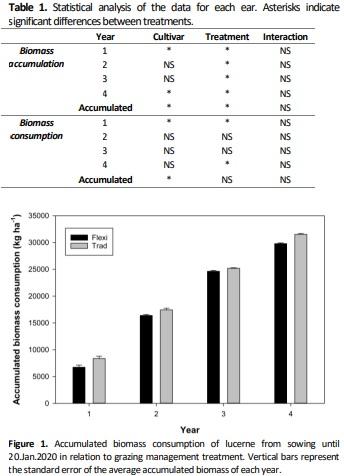Long term effects of fall dormancy and grazing frequency in lucerne (Medicago sativa L.) pastures: 1. Forage production and consumption
Published: December 15, 2022
By: Jáuregui J.M. 1,2; Berone G.3,4; Sciarreta F. 2; López Tessore M. 2; Garro L. 2; Bigliardi M. 2; Miri S. 2; Moot D.J. 5 / 1 Facultad de Ciencias Agrarias (UNL); 2 Gentos S.A.; 3 EEA INTA Balcarce; 4 Facultad de Ciencias Agrarias (UNMdP); 5 Lincoln University (NZ).
Introduction
Lucerne is the main grazed forage of Argentina. However, there is a large yield and consumption gap on most dairy and beef farms. Jáuregui et al. (2019) indicated that < 5 t ha-1 are consumed on average on dairy farms. There is potential to close the gap by increased grazing frequency, particularly during periods of high growth such as spring (Jáuregui et al., 2022). However, the long-term effects of such management on lucerne persistence and productivity, and the role of fall dormancy (FD) are unknown. The objective of this experiment was to compare the long term (i.e. 4 years) effects of two grazing frequencies (500°Cd [Trad] and 400°Cd [Flex] growing degree days [GDD]) and two cultivars (L820 [Fall dormancy 8] and Nobel 620 [Fall dormancy 6]) on lucerne production (i.e.biomass accumulation) and consumption.
Materials and Methods
A split plot rainfed experiment with 3 replicates was carried out at Gentos Research Station in Pergamino, Argentina (33°55' S 60°23' W). The soil is a typic Argiudoll with 14 ppm of P and 3.6% OM. The experiment was sown on March 29th, 2016 and fertilised at sowing with 80 kg ha-1 of Diamonium Phosphate. Seeds were direct drilled with an experimental seeder at a rate of 15 kg ha-1(~10 kg of bare seed). Sowing lines were 0,19 m apart. Fertiliser (Granucal®; [Ca= 123kg; Mg= 64kg]), was applied four times during the experimental period: once in Autumn 2018 (600 kg ha-1); twice in Autumn 2019 (1,200 kg ha-1); and once in 2020 (600 kg ha-1).
Main plots (10.5x20 m) were two cultivars (L820 [820] and Nobel 620 [620]) and subplots were the two grazing treatments: a traditional [Trad] grazing management, which corresponded to a year-round 500°Cd GDD grazing frequency and a flexible grazing management [Flex] which consisted of a 400°Cd GDD grazing frequency during increasing photoperiods and at least one rest (500°Cd) during declining photoperiods per year. Historical data of temperature was used to define ex-ante the day that each experiment was grazed. Base temperature used was 5°C. About 100 sheep (60 kg live-weight) were allocated to each grazing treatment (considering a 3% daily allowance) every time they reached their accumulated GDD. Sheep remained in each paddock for 2-6 hours (one grazing event).
Pre-grazing biomass was determined by cutting one 0.25 m2 quadrat per plot. Biomass sampleswere force-oven dried (80°C) to determine dry matter (DM) content of the samples. Post grazing biomass was measured on 40 occasions during the experimental period. The data were used to estimate total consumed pasture during the whole period by regressing the % of consumed pasture with the pre-grazing biomass. ANOVAs were used to analyse differences in biomass accumulation and consumption. Tukey tests were used for means separation at α = 0.05.
Results and Discussion
There was no interaction (P> 0,05) between grazing frequency and cultivars for either measured variable. The ex-ante approach to determine grazing frequency was imprecise, but differences (P< 0,05) between treatments were achieved throughout the experiment (588+/-15 vs 494+/- 11 average accumulated GDD, For Trad and Flex, respectively). When each year was analysed separately, accumulated biomass was higher for Trad than Flex in each of the four years (P< 0,05), while higher biomass was observed for 620 than 820 in year 1 with the opposite in year 4 (P< 0,05). Total accumulated biomass was also different (P< 0,05) between treatments (56,2 and 43,9 t ha-1 for Trad and Flex, respectively) and cultivars (51,7 and 48,5 t ha-1 for 620 and 820, respectively). A Logn regression that linked available biomass with consumed biomass proved to be highly efficient at predicting the average grazing efficiency (R2=0,8, P< 0,05; data not shown) and was used to estimate total consumed pasture during the experiment (Figure 1).

Conclusions
Despite Trad producing ~30% more forage, total consumed pasture did not differ between treatments. On the other hand, 620 accumulated more (P< 0,05) biomass and had higher total biomass consumption than 820 regardless of grazing treatment applied. Data from this experiment indicates that a higher grazing frequency could be applied to lucerne pastures of contrasting FD’s without compromising total consumed pasture. Such higher frequency could reduce the need for using post-grazing mowing and the costs associated with this practice. Also, higher forage quality linked to earlier commencement of grazing could increase total pasture consumption.
Presented at 45º Congreso Argentino de Producción Animal, organized by Asociación Argentina de Producción Animal (AAPA).
References
Jáuregui JM, Berhongaray G y Ojeda J (2019). Rev. Arg. de Prod. Anim. 39 (1): pp 242.
Jáuregui JM,Ojeda JJ, Berone GD, Lattanzi FA, Baudracco J, Fariña SR y Moot D J (2022). Ann. Appl. Biol., 1– 11.
Related topics
Authors:
Join to be able to comment.
Once you join Engormix, you will be able to participate in all content and forums.
* Required information
Would you like to discuss another topic? Create a new post to engage with experts in the community.
Create a post








.jpg&w=3840&q=75)